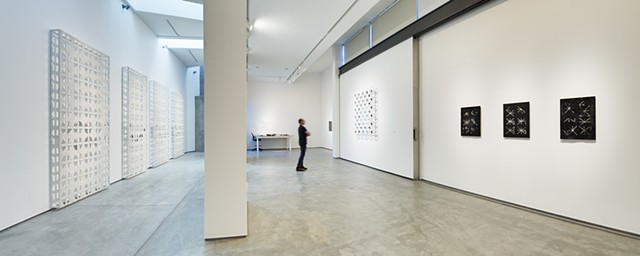Graft | ICA North
ICA North
Saturday, March 4, 2023 -
Sunday, August 6, 2023
icasandiego.org/art/edra-soto-graft/
For her exhibition Graft at ICA San Diego, artist Edra Soto (b.1971, Puerto Rico; lives and works in Chicago, IL) continues to create the site-specific installations that have defined this project since 2012. Using a range of materials from aluminum and PVC, to concrete and wood, Soto generates a sculptural language to express her experience navigating the Puerto Rican diaspora. For more than a decade, she has transposed two common and beloved elements of Puerto Rican residential architecture into foreign environments: the geometrically-patterned rejas (wrought-iron gates) and quiebrasoles (decorative concrete breeze blocks) that surround many of the island’s homes. This reconstruction of such distinctly Puerto Rican structures in faraway places offers a poetic meditation on national identity, displacement, and belonging.
In 2018, Soto began to incorporate viewfinders with snapshots of life on the island into the gaps within the Grafts, inviting visitors to peek through the patterned structures. What seems initially to be a voyeuristic gesture akin to peering through a neighbor’s fence becomes more abstract as Soto’s images come into focus. Rather than an intimate revelation of the private sphere to a public audience, Soto’s photographs bring everyday images of Puerto Rican life–from the mundane to the catastrophic–to audiences with otherwise limited access to such information. Through this combination of sculpture and photography, Soto reimagines national and cultural identity at a distance that is both spatial and temporal.
For her presentation at ICA San Diego, Soto will reconfigure a series of Graft works, altering colors, surface textures, and the photographic components to create a new installation. Prompted by the ICA’s season-long investigation of consumption in all forms, Soto’s San Diego presentation considers her Grafts as an alternative cultural symbol for Puerto Rico and Puerto Rican identity both on the island and in the tourist trade. In place of the ubiquitous imagery of Spanish castles, fortresses, and watchtowers (garitas)–emblems of colonial power that appear on everything from restaurant menus to airport seat cushions, Soto proposes her Grafts as a new kind of marker for the nation. These familiar forms, whose influences include often-overlooked West African design traditions, reflect Puerto Rico’s diversity and offer a counter to the inequitable narrative embedded in representations of colonial domination. They are instead authentic signifiers of home.







